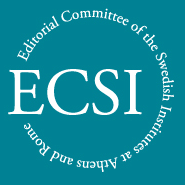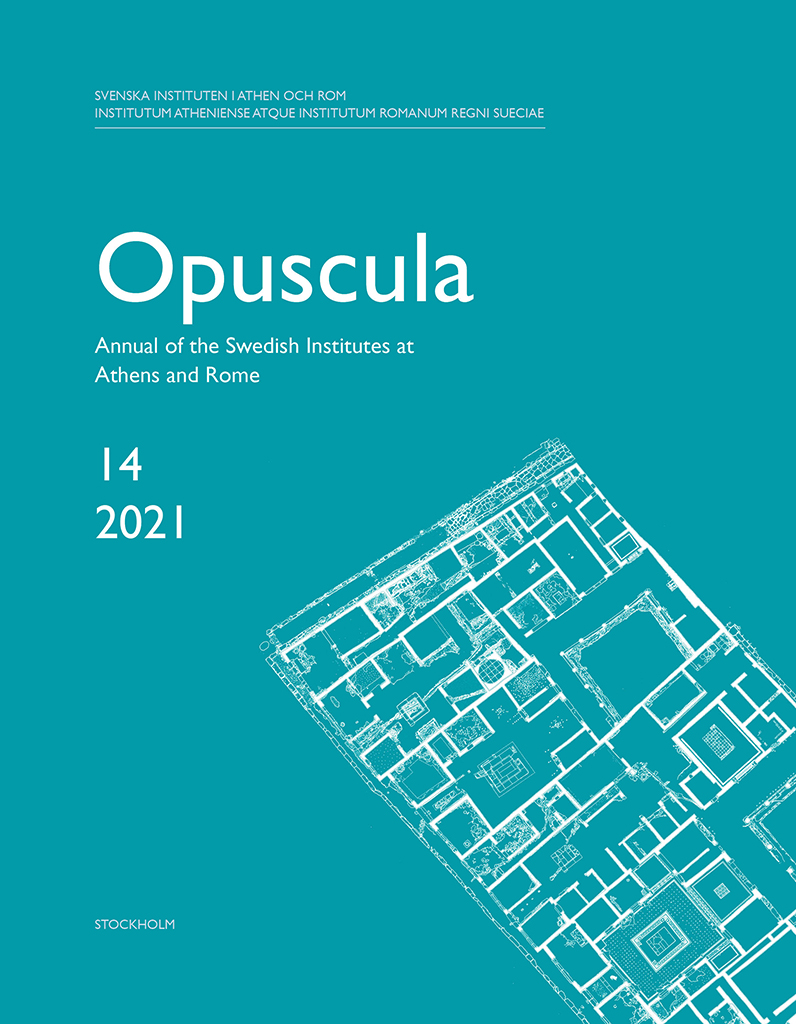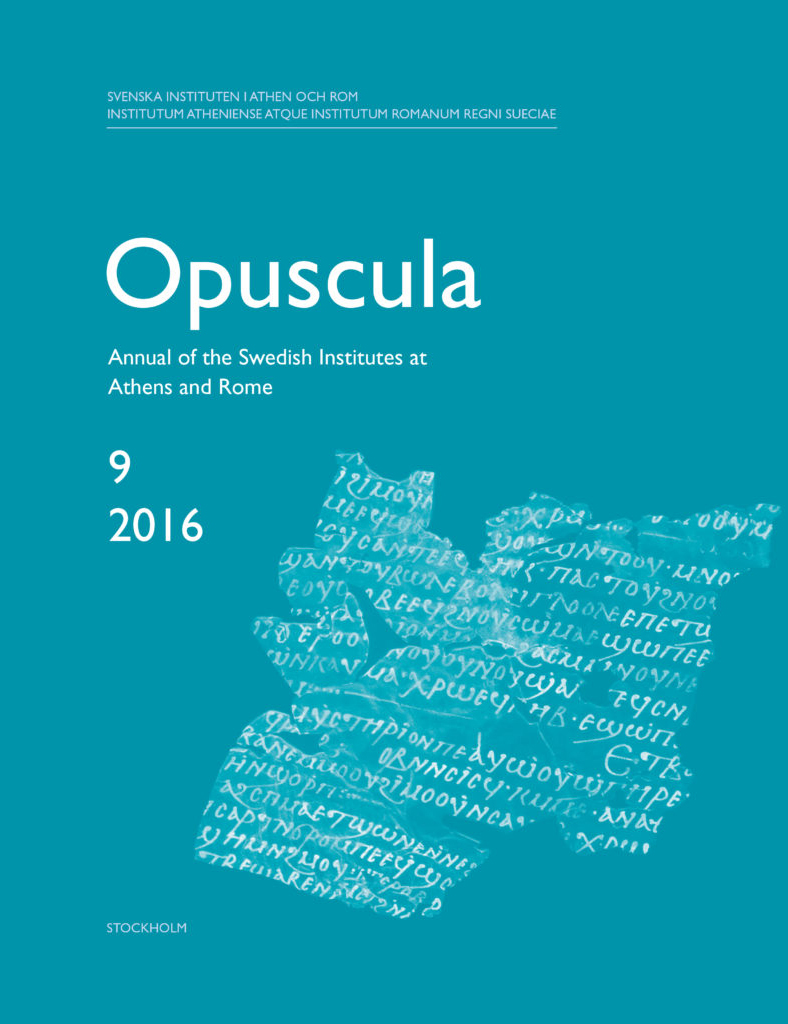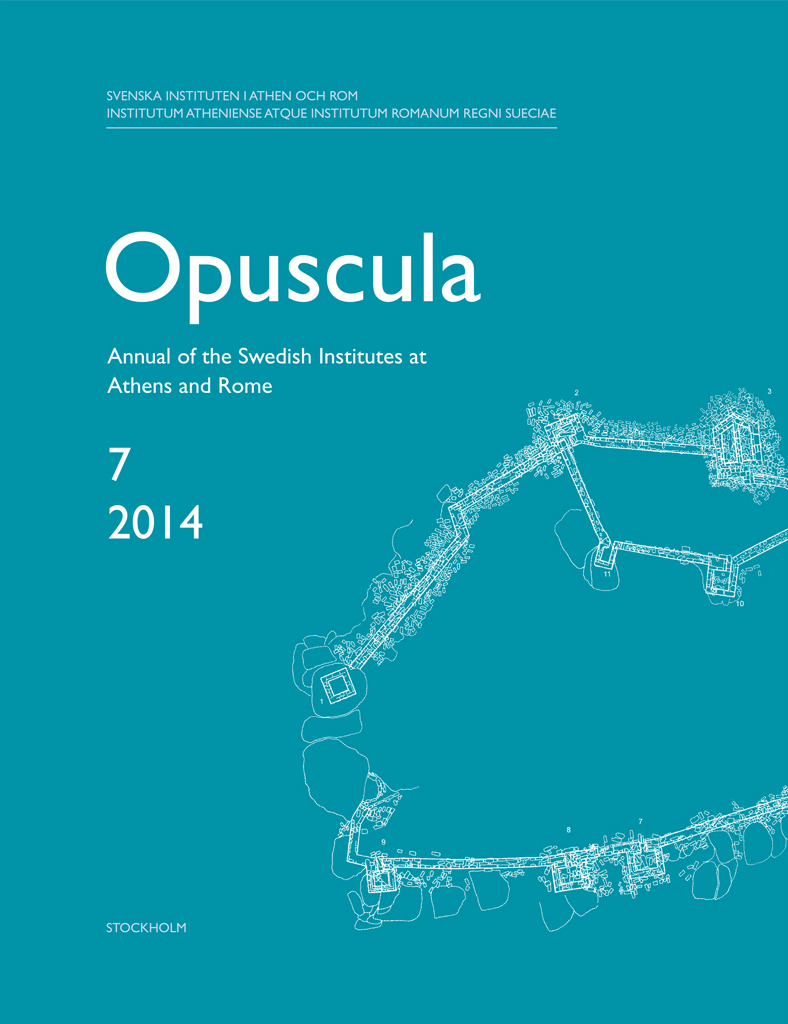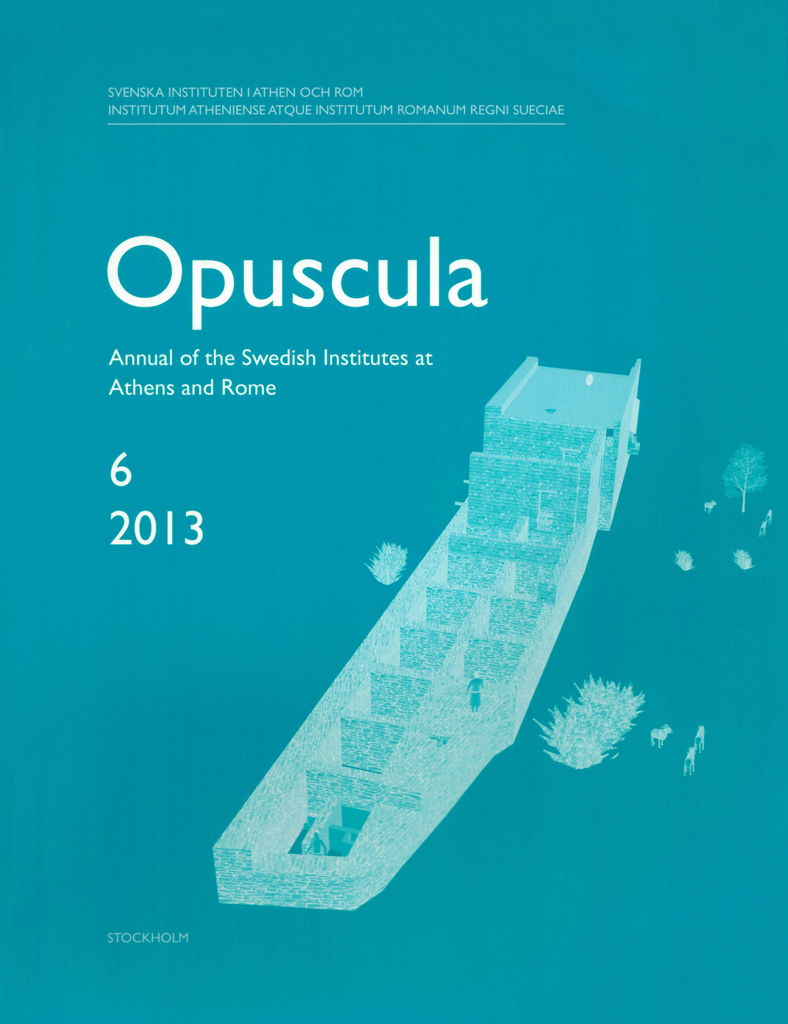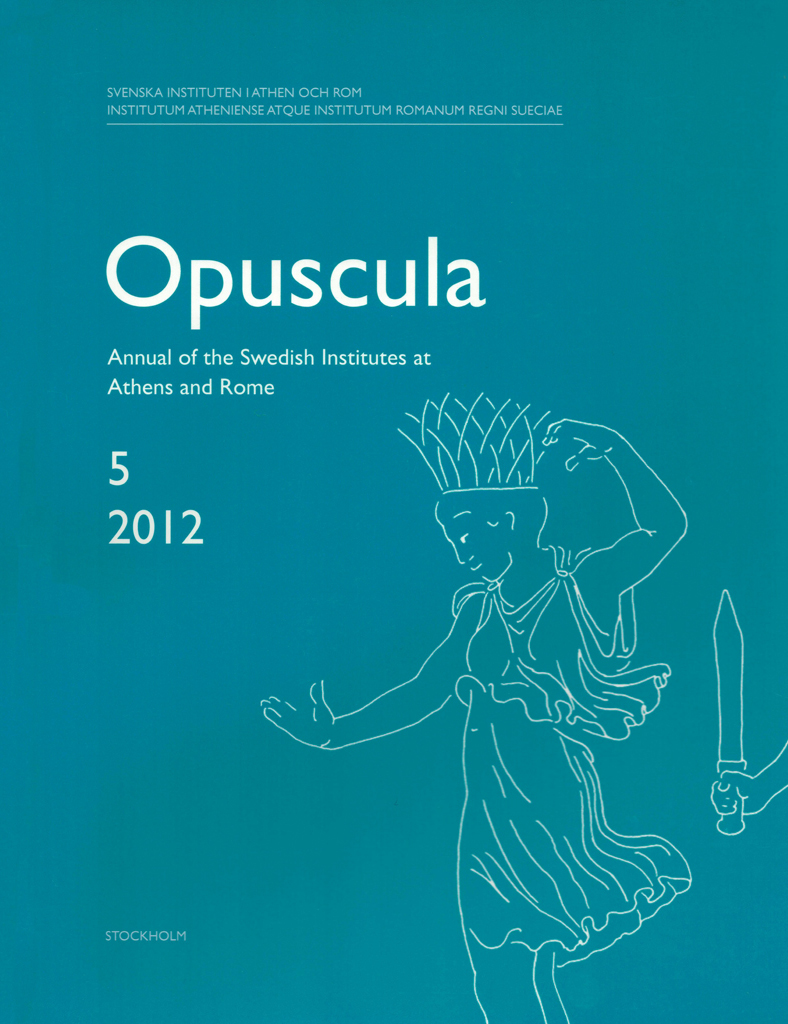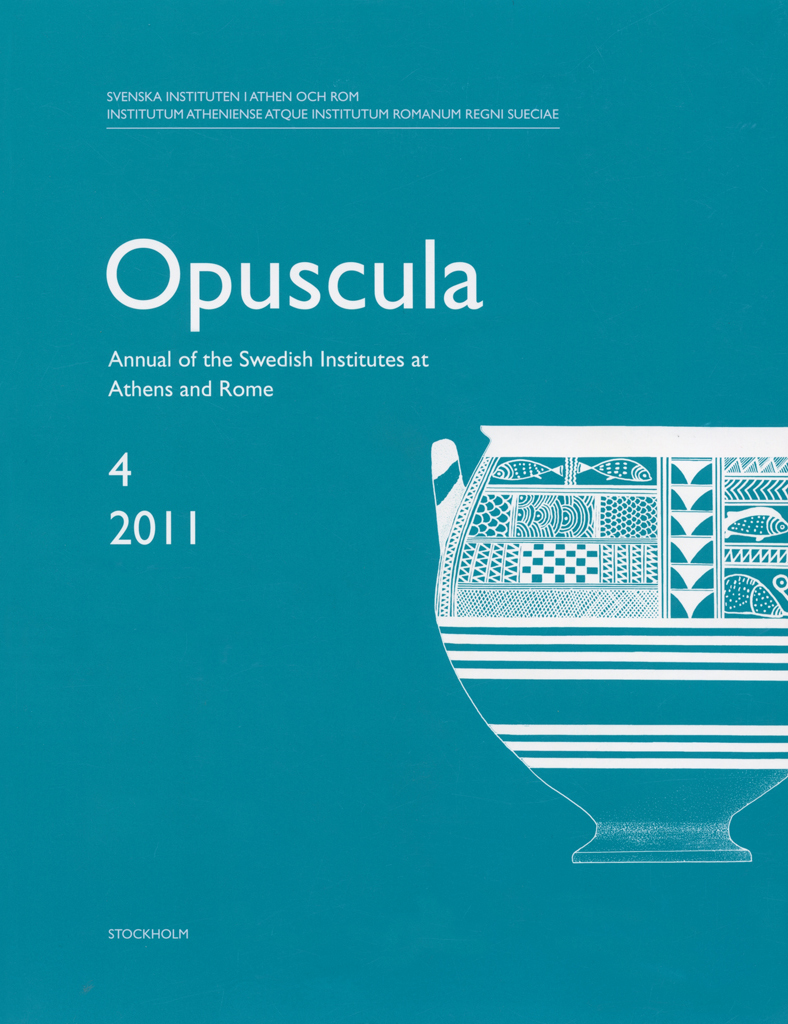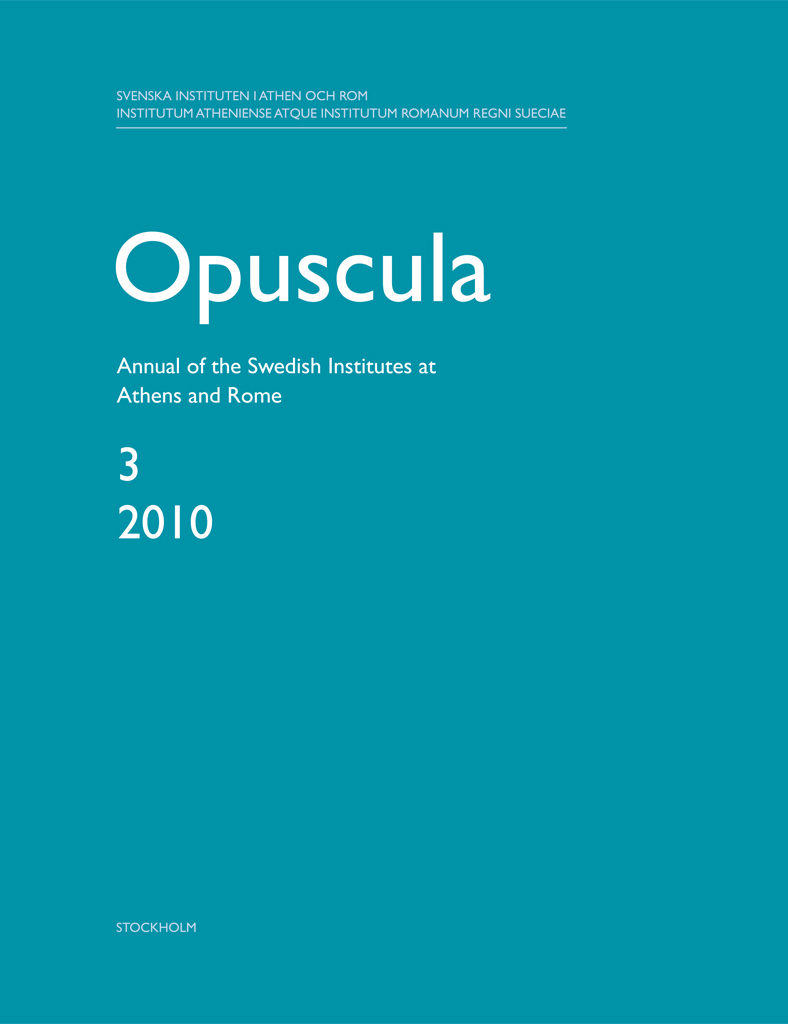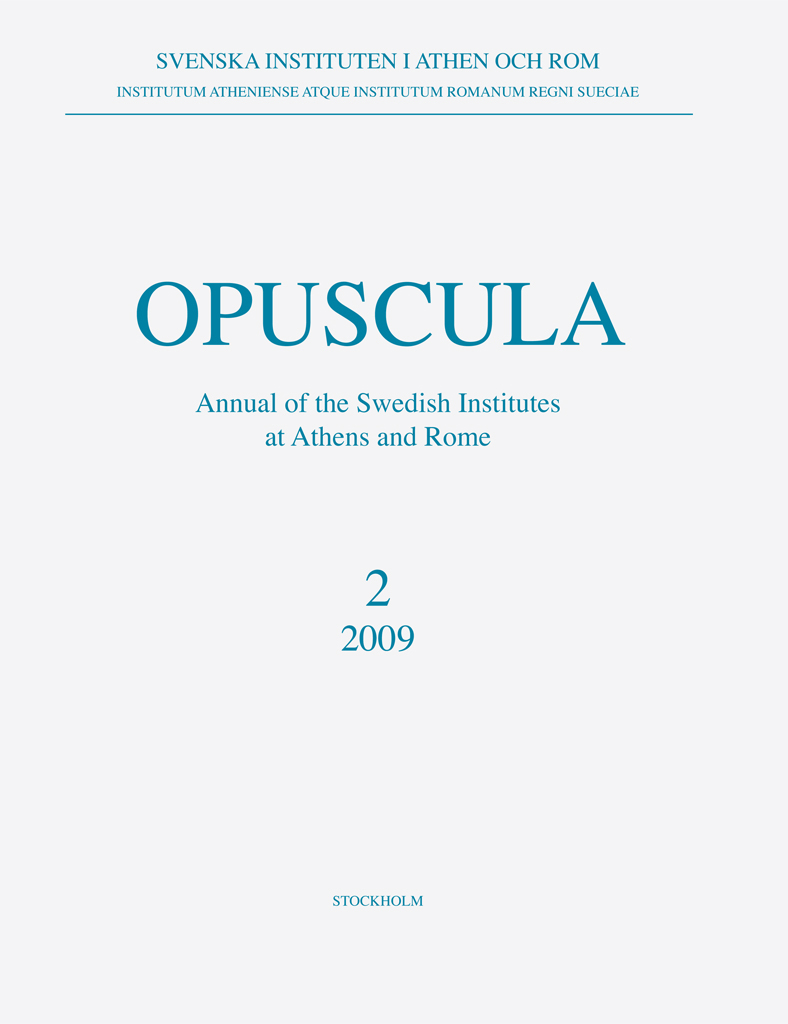Opuscula is published by the Swedish Institutes at Athens and Rome, with the aid of a grant from the Swedish Research Council. Distributed by Eddy.se AB. View journal at ERIH PLUS. All content available with open access. Pergamos. An unexplored fortified site in north-eastern Greece By Patrik Klingborg (Uppsala University), Georgia Galani (Swedish Institute at Athens), Jesper Blid (Independent scholar), Stavroula Dadaki (Ephorate of Antiquities of Kavala) & Penelope Malama (Ephorate of Antiquities of Kavala) Abstract The aim of this article is to present the first results of a project investigating the hitherto unexplored site of Pergamos, located on a hill known as Koules/Alonaki just to the south of modern Moustheni in the Pieria valley. The site has a long history, with the earliest traces of human activity dating to the Late Bronze Age and the first visible architectural remains—impressive and well-preserved fortifications built in a stack-work technique—originating in the Late Archaic period. Following this, surface finds testify to activity and habitation throughout the centuries until a substantial strengthening of the defensive walls during Late Roman or medieval times, before the site was abandoned at a currently unknown point. To achieve the aim the article begins with an introduction to the site…
Opuscula is published by the Swedish Institutes at Athens and Rome, with the aid of a grant from the Swedish Research Council. Distributed by Eddy.se AB. View journal at ERIH PLUS. All content available with open access. The Temple of Demeter Chthonia at Hermione By Jesper Blid (Austrian Academy of Sciences, Austria), with an appendix by Baukje van den Berg (Central European University, Austria) Abstract This paper presents the results of an architectural survey of the foundations of a Classical temple, presumably that of Demeter Chthonia, located inside the chief sanctuary of the ancient city of Hermione. It also studies ancient architectural members built into the walls of the Taxiarches Church situated on top of the temple foundations. By analysing these material remains and connecting them to the observations of 19th-century travellers to Kastri (Hermione), the paper draws conclusions about the original size and appearance of the Temple of Demeter Chthonia. Bibliographical information Jesper Blid, with an appendix by Baukje van den Berg, ’The Temple of Demeter Chthonia at Hermione’, Opuscula. Annual of the Swedish Institutes at Athens and Rome (OpAthRom) 14, Stockholm 2021, 101-134. ISSN: 2000-0898. ISBN: 978-91-977799-3-7. Softcover, 478 pages. https://doi.org/10.30549/opathrom-14-07 Hermione. A Greek cityscape and its people The…
Published by the Swedish Research Institute in Istanbul (SRII) and distributed by Eddy.se AB at srii.bokorder.se. Also available for purchase at Amazon.com, Bokus.com, and Adlibris.com. The Labraunda-series is edited by the Editorial Committee of the Swedish Institutes at Athens and Rome. Labraunda 5. The Andrones By Pontus Hellström and Jesper Blid Abstract This is the final publication of the two Hekatomnid Andrones at Labraunda. The older of these (the Andron of Maussollos or Andron B) was built by the satrap Maussollos (377/6–353/2 BC). This is shown by the dedicatory inscription on the architrave. The other andron (Andron A) is clearly later and was probably built by Idrieus (351/0 344/3 BC), the brother and successor of Maussollos as satrap of Karia. This building has the same kind of dedication, but the name of the commissioner is not preserved. These two buildings are unique both for their size, temple-like front, and high degree of preservation and for their Ionic-Doric mixed order, the function as banqueting halls, and the large niche at the back of the inner room. In the publication the architecture of the two buildings is systematically presented together with plans and elevations of the ruins and reconstructions. The walls are…
Opuscula is published by the Swedish Institutes at Athens and Rome, with the aid of a grant from the Swedish Research Council. Distributed by Eddy.se AB. View journal at ERIH PLUS. All content available with open access. Excavations at the Monastery of St Antony at the Red Sea By Jesper Blid, Fr Maximous El-Antony, Hugo Lundhaug, Jason Zaborowski, Meira Polliack, Mengistu Gobezie Worku & Samuel Rubenson Abstract This paper discusses the results from recent archaeological investigations at the Monastery of St Antony in Egypt, including the remains of a number of building phases predating the current church, locally produced pottery, and manuscript fragments written in Coptic, Arabic, Hebrew, and Ge’ez. Introduction St Antony is, according to tradition, the early 4th-century institutor of Christian monasticism, and his monastery, located some 30 km from the Red Sea coast and about 125 km south of Suez, is regarded as the oldest still-inhabited monastery. As for the chronology of the actual material formation of a monastery at the site, Antony must have settled here sometime before 337, if we are to believe the biography written by Athanasius of Alexandria shortly after his death. Several sources from the end of the 4th century mention the…
Opuscula is published by the Swedish Institutes at Athens and Rome, with the aid of a grant from the Swedish Research Council. Distributed by Eddy.se AB. View journal at ERIH PLUS. All content available with open access. Labraunda 2012-2013. A preliminary report on the work at the sanctuary. With a new reconstruction drawing of the sanctuary by Jesper Blid Kullberg and an appendix by Fredrik Tobin By Lars Karlsson, Jesper Blid Kullberg, Baptiste Vergnaud, Agneta Freccero & Fredrik Tobin Abstract This article is divided into two parts. In the first part, preliminary reports on the archaeological work conducted at the sanctuary during the years 2012 and 2013 is presented, and in the second part, two conservation projects are discussed. The first part includes a description of the excavations at the Split Rock by Lars Karlsson, an account of the excavations on the slope of the Monumental Tomb, a description of the work at the Akropolis Fortress gate by Baptiste Vergnaud, and a synopsis of the work at the M-Building. The second part starts with a report on the preparations for the stabilization of Andron A and continues with an account of the last two years of marble conservation by Agneta…
Opuscula is published by the Swedish Institutes at Athens and Rome, with the aid of a grant from the Swedish Research Council. Distributed by Eddy.se AB. View journal at ERIH PLUS. All content available with open access. Book reviews Jesper Blid | Building a new Rome: The imperial colony of Pisidian Antioch (25 BC–AD 700), eds. E.K. Gazda & D. Y. Ng, in collaboration with Ü. Demirer, Ann Arbor, Michigan 2011. 219 pp., 168 ills. +1 video disc. ISBN 978-0-9741873-4-1. https://doi.org/10.30549/opathrom-06-11 Anton Bonnier | E. Farinetti, Boeotian Landscapes. A GIS-based study for the reconstruction and interpretation of the archaeological datasets of ancient Boeotia (BAR-IS, 2195), Oxford: Archaeopress 2011. xiv + 425 pp. + 1 CD. ISBN 978-1-4073-0750-3. https://doi.org/10.30549/opathrom-06-12 Maja Kramer | G. López Monteagudo, M.L. Neira Jiménez, ‘Mosaico’, in Arte Romano de la Bética. Mosaico. Pintura. Manufacturas, ed. P. León, Sevilla: Focus-Abengoa 2010. 381 pp., 482 ills. ISBN 978-84-89895-27-0. https://doi.org/10.30549/opathrom-06-13 Gullög Nordquist | Mesohelladika. La Grèce continentale au Bronze Moyen. Actes du colloque international organisé par l’École française d’Athènes, en collaboration avec l’American School of Classical Studies at Athens et le Netherlands Institute in Athens, Athènes, 8–12 mars 2006 (BCH Suppl., 52), eds. A. Philippa-Touchais, G. Touchais, S. Voutsaki &…
Opuscula is published by the Swedish Institutes at Athens and Rome, with the aid of a grant from the Swedish Research Council. Distributed by Eddy.se AB. View journal at ERIH PLUS. All content available with open access. Labraunda 2011. A preliminary report on the Swedish excavations with an appendix by Ragnar Hedlund By Lars Karlsson, Jesper Blid & Olivier Henry Abstract The main goals of the 2011 campaign were the excavation of the Kepez tower, the West Church and the necropoleis. The tower of Kepez was excavated and black-gloss pottery indicates a date in the 3rd century BC. The 2011 excavations in the West Church uncovered three Late Roman and Byzantine building phases. Among the finds from Late Antiquity was a well-preserved glass lamp with a Greek inscription and a marble figurine, possibly representing an apostle or a saint. The excavations in the necropolis uncovered eleven tombs in the Area 5B, located along the Sacred Way, completing the excavation initiated in 2010. New tombs were discovered in the territory east and south of the sanctuary. Finally, the three stone sarcophagi inside the Built Tomb were moved in order to facilitate complete excavation and the cleaning of all the interior space…
Opuscula is published by the Swedish Institutes at Athens and Rome, with the aid of a grant from the Swedish Research Council. Distributed by Eddy.se AB. View journal at ERIH PLUS. All content available with open access. Labraunda 2010. A preliminary report on the Swedish excavations By Lars Karlsson, Jesper Blid & Olivier Henry Abstract The campaign of 2010 continued the work which was initiated last year. The excavations in the fortress on the Tepesar Hill were completed. The fortress consists of a large, early Hekatomnid tower where two black-gloss vessels indicated a dating of the tower to about 380–350 BC. In the two additions to the tower, several wellpreserved vessels dating from the 3rd century BC were uncovered. The latest fragment was a painted piece from a lagynos from around 200 BC, but there were no fragments of Megarian bowls. The test probe of last year in the West Church Complex was extended to a larger trench measuring c. 9 × 12 m. Evidence for three major phases could be established by J. Blid: (1) a Late Classical stoa; (2) the stoa colonnade is rebuilt into a Christian basilica of the 5th century AD; (3) a Middle Byzantine building…
Opuscula is published by the Swedish Institutes at Athens and Rome, with the aid of a grant from the Swedish Research Council. Distributed by Eddy.se AB. View journal at ERIH PLUS. Content available with open access. Labraunda 2009. A preliminary report on the Swedish excavations with contributions by Jesper Blid and Olivier Henry By Lars Karlsson Abstract The 2009 campaign in Labraunda accomplished three goals: the termination of the excavations in the Byzantine fort on the Acropolis and in the Late Roman Tetraconch and the complete excavation of the impressive marble chamber tomb along the Sacred Way. In the Acropolis Fortress, evidence was found to support the military character of the Byzantine establishment: the rooms along the fortification wall were paved and had a rectangular shape, suggesting defensive rooms. In these rooms sling stones were found. Structures dating from the Hekatomnid period were further investigated this year, and a well cut into the gneiss bedrock was excavated. In the Tetraconch, the north apse was excavated down to bedrock and a coin from Constantius II (348–357/8) suggests an ante quem dating for this unique and sophisticated structure. The geophysical investigations indicated that a church is located on the terrace below the…
Opuscula is published by the Swedish Institutes at Athens and Rome, with the aid of a grant from the Swedish Research Council. Distributed by Eddy.se AB. View journal at ERIH PLUS. All content available with open access. Labraunda 2008. A preliminary report on the Swedish excavations By Lars Karlsson, Jesper Blid & Olivier Henry Abstract The Swedish archaeological project at the Karian sanctuary of Zeus Labraundos celebrated, in 2008, sixty years of work. The year 2008 was very special, both because of these celebrations, but also because of the important finds that came to light during the excavation of the unusual Roman bath that was discovered in 2007. It is built in the shape of a four-leaf clover (the so-called Tetraconch), and can be dated to the first half of the fourth century AD. A large amount of finds were discovered, including superb pieces of plates in African Red Slip and Late Roman C wares, a water flask, and coloured marble pieces. In the necropolis, we excavated another 19 rock-cut tombs. The finds from these include a golden ring with a cornelian stone and 22 gold appliqués in the shape of rosettes and palmettes. The appliqués had four holes to…
